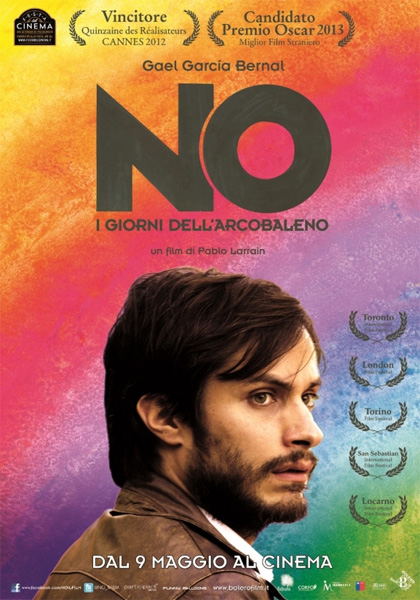May 31 – June 6 at the Gene Siskel Film Center, Chicago
In the Oscar-nominated Chilean film “No,” filmmaker Pablo Larraín (“Tony Manero”) tells the story of Chlie’s 1988 referendum through the eyes of an advertising executive hired to run the campaign against the country’s dictator Augusto Pinochet. Gael Garcia Bernal (“Amores Perros”) stars as René Saavedra, a commercial ad man who brings an unconventional marketing plan to the political arena in hopes of ending Pinochet’s 17 year reign.
“No” was nominated for an Oscar last year. It marked the first time Chile was nominated for an Oscar in the Best Foreign Language category since the country began submitting films for Oscar consideration in 1990. What was your reaction to the news?
It was fantastic. We started submitting movies for Oscar consideration in 1990 because the dictatorship was over. Before that, it was really hard to make movies.The nomination comes on different levels. One, it helps me in my career, which is something I completely ignore. Two, it helps the movie, which is the most important thing. Now, more people will be aware of it when it’s released.
You were only a child when the national plebiscite took place in 1988. What do you remember about that time in Chile and how did it affect your family?
Well, my family was never exposed to any type of danger. We were not part of a lot of the pain and violence a lot of people suffered. But what I do remember is the mood in Chile. There was something in the air, like a sensation. That’s what I wanted to capture in the film, too. It’s not only about the story and the dramatic plot. It’s also about the atmosphere. I tried to capture that from the memories and feelings I grew up with. The sensation I’m talking about is heavy an unsettling. It was a super grey moment in Chile’s history.

What side of history was your family on during this time? Did they support Pinochet?
Yes, they supported Pinochet just like half of the country was. The people who were in danger were the ones who were against Pinochet.
So, you were brought up in a home where government and politics were part of everyday life. Your father was a senator and your mother once worked as the minister of Housing and Urbanism. How did this influence you as you grew up?
It’s hard to tell because my parents supported Pinochet, but my grandparents were on the No side. Everyone had a different perspective. What I do know is that no matter what you think, the fact that I was in this political environment just got me interested in the subject. I thought there was something there that would make a good movie.
How many of the 27 nights of advertising did you actually watch as research for the film?
All of it. Both sides. I even got access to a lot of material that didn’t air.
What surprised you the most about the campaigns during your research?
It was the freshness of the No campaign. It was something truly unbelievable in how they did it. مواقع القمار العالمية Every day they did better and better and better. It’s unbelievable now when you watch what happened – and with the perspective of time – how something like that could be possible. During those 27 days, the guys on the No campaign just trusted so much in what they were doing. The people on the Yes side would switch what they were doing every two days because they were confused. ماهي لعبة البوكر
Talk about your decision to make this film look like it was shot on videotape. ربح المال مجانا How do you think this decision enhances the story you’re trying to tell? For me, I loved the fact that you really couldn’t tell the difference between the real footage you used during that time and the film itself.
Thanks, I agree with that. It was very important for us to create an illusion. At least 1/3 of the film is real footage, so it was very important that the audience connected with the movie in that way. We didn’t want them to have to reconnect with it every time they saw the movie in a different format. Sometimes a movie uses just a little bit of real footage, so it doesn’t bother me. But for “No,” we were going to use so much of it, we thought it would be distressing for the audience and would break the illusion somehow. I think it’s pretty important that most people don’t know once the movie has begun what exactly is archival footage and what is not.